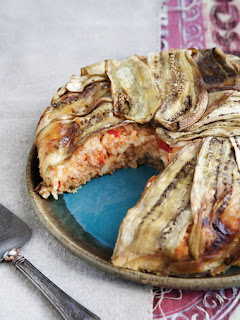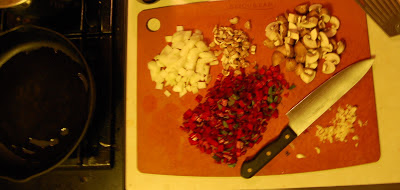I was recently surfing the web, following one idea to the
next down some proverbial rabbit hole and ended up inspired a blogger (Brow-Eyed
Baker) who had a tab entitled ‘My 100’.
It was a culinary bucket list of sorts that she had compiled, comprised
of the many dishes she hoped to conquer in the kitchen. And that got me thinking – why not put
together a list of all the yummy things that
aren't, by nature, vegetarian
gluten-free that we could try to make that way?

Now most of the things on the list are already vegetarian
OR gluten-free, so should not be too difficult to adapt. Some dishes did rise to the top of the difficulty
meter, by being neither veg nor gf (French onion soup, beef stroganoff, sausage
& chard strata, grilled burgers, meatloaf, Chinese-style lemon chicken), by
being very hard to substitute with gf products (fresh pasta, gnocchi, ravioli, a
‘real’ baguette, tiramisu, spanakopita, samosas), by being difficult to approximate
with gf veggie protein (beef burgundy, paella, bacon, lardons), or by being
just technically difficult (soy cheese,mozzarella, verjus).
I’ve nicknames them ‘The Tricky Twenty” and they are highlighted in bold in the
list below.
Observant types might have notice mozzarella – hey, that is vgf already, what gives? Well, that’s where the rest of the ‘bucket
list’ comes in. I ended up with 75 items
to adapt, but as the ideas were rolling in I started thinking of some culinary
delights I would love to create, just for the joy of it. These 25 loosely fall into fresh cheese
making, pickling, and creating other things from scratch - like homemade mayo.
I’m sure this is just the tip of the iceburg, but it is a
good start – and a way to inspire me in the kitchen when I’m thinking ‘what
should I make
today?’. I’ve reposted it in its own tab too (without
the commentary), where I will cross off dishes as they are developed and pass
muster (along with the inevitable failures). See
My 105. Bonus is that we have already made
meatloaf and mac 'n' cheese - yay! I want to know from you – what is on your
100? What are you struggling to adapt to
meet your needs? Let me know and we can
work at it together.
Italian Delights
1. Fresh pasta - A quintessentially ridiculous
dish to make gf.
2. Gnocchi - We have tried, failed, and
will try again.
3.
Lasagna - What could be more homey and delicious?
4.
Eggplant parmigiana – Successfully breading the
eggplant may also lead to parmigiana sandwiches.
5.
Pasta e fagioli - Pasta and beans, traditionally
favas.
6.
Stuffed zucchini blossoms - Usually dredged in
flour and stuffed with breadcrumbs.
7.
Arancini - Risotto balls usually bound with
breadcrumbs or panko.
8. Ravioli - Once the pasta is figured out
we can explore these beauties.
Bread! & Baked Things
9. A ‘real’ baguette - A HUGE treat, yet
to find one gf that passes muster.
10.
Biscuits - Almost as good as a baguette.
11.
Flatbread - Pita, na’an, or chipatis, looking for whatever
will work best.
12.
Good sandwich bread - Something that will hold
up to mayo and all the fixin’s.
13.
Whole brown rice bread - A mythic, traditional
Japanese loaf that sounds fabulous.
14.
Sprouted grain bread - Why can’t it be gf
too? Easier to digest than flour.
15.
Pizza dough - Enough said! A craving for us gf folks.
16.
Quick bread - Something that can be adapted to
sweet or savory ends
17.
Muffins - Would love to replicate my mom’s
Pumpkin Crunch in gf!
18.
Cottage cheese bread - Have some very nostalgic
memories of this, with lots of dill.
19.
Crackers - A must for all the fresh cheese
further down the list.
Sweets
20.
Angel food cake – My absolute fav as a kid.
21.
Fruit galette - My absolute fav now.
22.
Broken glass dessert - A jello & whipped
cream concoction of my Grandma’s with lots of memories J
23.
Cheesecake - Who doesn’t love a good cheesecake?
24.
Brownies - Hard to resist, even for us non-dessert types.
25.
Meyer lemon curd - The quintessential lemon
indulgence, I have to try it.
26.
Vegan fruit crisp - Loooove fruit crisp, why not
make it more inclusive?
27. Tiramisu - Lots of gf hurdles with this
one, homemade ladyfingers?
28.
Gingerbread cookies - Another sweet soft spot.
29.
Shortbread - We’re Scottish, after all!
30.
Chestnut flour cake - Intriguing traditional
Italian confection.
31.
Decent tart shell - That can take a bunch of
seasonal fruit & still behave.
Savory Pastries
32.
Gourgettes - French cheese puffs, would love to
make these work out.
33. Spanakopita - Miss this
fantastic combination of feta & spinach.
34. Samosas - One of the best, hearty snack
foods I used to adore.
35.
Empanadas - Latin American handpies, maybe with
maseca?
36.
Turnovers - Infinitely stuffable with goodness.
Soups & Stews
37. French onion soup - Beef broth &
bread slice make this a double hurdle.
38.
Mulligatawny soup - Creamy, curry chicken with
surprises of apple.
39.
Naomi Pomeroy’s celery velouté - Looks divine,
but started with a roux.
40. Miso
soup - Complete restorative; usually has bonito fish broth.
41.
Posole - Heartwarming soup with hominy, pork and
chicken.
42.
Pho - The Vietnamese staple that hits all the
right notes.
43.
Guinness stew - How to get that rich beefy
goodness in veggies form?
Main Events
44. Meatloaf - JJ’s favorite, especially
for sandwiches
45.
Falafel - One of my favs, but often adulterated
with wheat flour, and served in a pita.
46. Beef burgundy - Julia Child might not
be impressed, but I am determined!
47. Beef stroganoff - A yummy classic that
needs much VGF revision.
48. Mac
& Cheese - Oh yah!
49. Sausage & Chard Strata - Found this
bread-based recipe and just have to try it.
50. Burgers that can be grilled - If only…
without breadcrumbs they tend to fall apart.
51.
Beef burgers - Looking for depth of flavor and
great texture
52.
Chicken burgers - Something lighter but still
substantial with some zing.
53.
Lamb kofta - Trying to be like our friend
Huseyin, who makes it best
54.
Soufflé - For those fancypants dinner parties, usually contain flour
55.
Shepherd’s pie - Rich and comforting even in VGF
form
56.
Chicken wings - If it’s coated in good sauce,
will you know that it’s tofu?
57. Bacon - Working for that smoky somtin’
somtin’.
58.
Paella - How to make so many kinds of meat
replacements?
59.
Dirty Rice - A New Orleans staple.
60. Lion’s
head meatballs - Pork-based Chinese wonders.
61. Chinese-style lemon chicken - A guilty
favorite.
62.
Carne asada - Gimme spice!
63.
Shredded beef - Love the texture, would love in
more on a sandwich.
64. Lardons - Pork belly cubes of saturated
goodness, might be hard to make veggie style.
65.
Butter chicken - Love it!
66. Jerk
chicken - Bring on the heat…
67.
Chili - A favorite of sporting events, sloppy
sandwiches, & nachos
68. Something
tea-infused - Totally intrigued by the cover of Culinary Tea.
Faux Dairy
69. Vegan
“butter” - There has to be something healthier to dip my artichokes in.
70.
Vegan cheese sauce - Morbid curiosity.
71.
Vegan mayo - We use veganaise, but it is getting
sooooo expensive!
72.
Almond milk - Homemade has to be better, right?
73.
Soy milk - Intrigued, because of the following
two possibilities:
74.
Soy yogurt - Does this work or taste okay?
75. Soy cheese - Is this possible at home?
{Onto those that are just for the fun of it….}
Fresh Cheese & Dairy Delights
76. Mozzarella - Mmmm fresh mozza with
tomatoes, basil & olive oil.
77.
Ricotta – Yummy.
78.
Ricotta salata - Double yummy.
79.
Mascarpone - Is seem some great dessert
potential.
80. Paneer
- Then onto peas paneer, one of JJ’s fav Indian dishes.
81.
Queso blanco - A must for the Latin dishes.
82.
Quark - The oldest form of cheese in Europe,
dates to 3 B.C.E!
83.
Feta - Can you imagine fresh feta at home?!?!?!
84. Chèvre
- Another big favorite – though JJ isn’t as fond of it as I am.
85.
Soft goat cheese - Apparently there is a
difference between this and chèvre.
86. Goats
milk mozzarella - Interesting…
87.
Sour cream - I’ll try it at least once, just to
see.
88. Crème
fraîche - And then onto Truffled Crème Fraiche!
89. Butter
- Looks too easy not to try.
90. Ice
cream - Saw a recipe for white chocolate ice cream, so have to try it.
91.
Paskha - An interesting looking Russian Easter
‘dessert’ made in clay flower pots! HAVE to try that!
Canned & Homemade
92.
Dill pickles - A classic, growing my own cucs
this year too!
93.
Pickled eggs - Not as weird as you think, now
I’m addicted!
94. Pickled
beets - Just for Kim J
95.
Picked asparagus or beans - I won’t lie, they're destined for Homemade bloody marys.
96. Pickled
hot peppers – Addictive! Thinking of you, Shelly!
97.
Giardiniera - A classic Italian picked veg
medley that is delicious.
98. Verjus - Vinegar made out of unripe
grapes, and boy do we have grapes.
99. Low-sugar
fruit jam - Apricot, fig or blueberry? Decisions decisions.
100. Pear
or apple butter - Fruit purees that you spread like butter caught my interest.
101. Apple
sauce - Just to try, probably destined for baking.
102.Homemade mayo - A must.
103. Homemade mustard - A cool
looking Roman mustard recipe sparked this.
104. Homemade
ketchup - Because the stuff from the store is SCARY.
105.Own Montréal steak spice - One
of our secret weapons, so why not make it our own?




